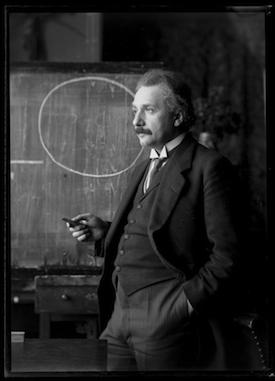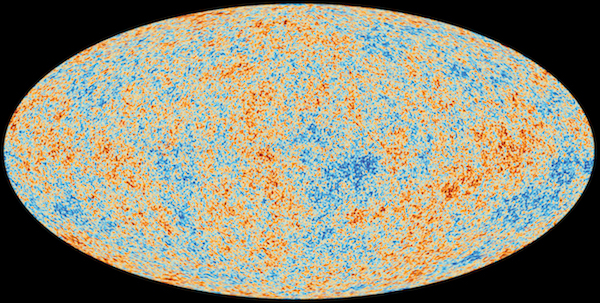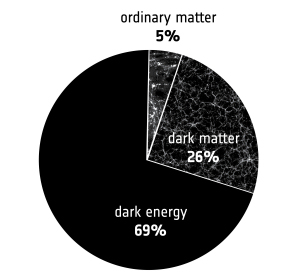Mission science
Cosmology is the study of the Universe on its largest scales. This includes the formation of the Universe and its subsequent evolution. The field began in earnest in the second decade of the 20th century when Albert Einstein published his theory of General Relativity. This provided a mathematical framework for a description of the Universe as a whole.
Just over a century later, it is now widely accepted that ordinary atoms make up only a small fraction of the energy density of the Universe. This means that around 95 percent of everything is now thought to be in unknown forms of matter and energy.
Astronomers have called these components dark matter and dark energy to reflect their mysterious nature. Dark matter adds gravity to the Universe on the scale of galaxies and clusters of galaxies, whereas dark energy acts on the larger scale and causes the accelerated expansion of the Universe.
By combining this dark sector with ordinary matter cosmologists have constructed an extraordinarily accurate description of the Universe's behaviour. It is called the lambda-CDM model, where lambda indicates the dark energy and CDM stands for cold dark matter.
 |
| Albert Einstein in 1921. Credit: ÖNB/Wien, LSCH 0075-C |
Lambda is also known as the Cosmological Constant. It was first introduced by Albert Einstein in his model of the Universe. At the time everyone believed in the assumption that the Universe was a static, unchanging place. So, Einstein used lambda to help balance the gravity in the Universe.
The journey towards our modern lambda-CDM began in 1927 with Belgium astrophysicist Georges Lemaître's prediction of the expanding Universe from his analysis of general relativity. Two years later, American astronomer Edwin Hubble confirmed Lemaître's prediction by using observations of distant galaxies to show that they were systematically moving away from us. This is now known as the Hubble-Lemaître law.
In his analysis, Hubble correctly showed that an optical phenomenon called redshift was correlated to distance, exactly as would be expected if the Universe is expanding. Redshift is the stretching of a celestial object's light. The phenomenon was discovered in galaxies in 1912 by the American astronomer Vesto Slipher, and is most easily explained if the galaxy in question is moving away from us.
Hubble's colleague, the American astronomer Milton Humason, began an extensive observational programme to investigate the redshift of galaxies, and these observations furnished Hubble with the data he needed to show that the amount of redshift displayed by a galaxy is related to its distance from us, confirming Lemaître's predictions.
In 1931, Lemaître used further analysis to propose that the Universe once existed in an extremely compact state. This was the genesis of the idea we now call the big bang. The compact early state of the Universe was confirmed in 1966 with the discovery of the cosmic microwave background radiation (CMB).
 |
| The Cosmic Microwave Background - as seen by Planck. Credit: ESA and the Planck Collaboration |
The CMB is a universal bath of low energy radiation that represents the very first 'light' that was present in the Universe. Some call it the relic radiation, or the remaining radiation from the fireball of the big bang. Its existence was predicted by the Soviet-American cosmologist George Gamow, who also showed that the big bang could finally explain the relative amount of hydrogen, helium and lithium in the Universe.
The CMB's properties are affected by the amount of matter and energy of all types in the Universe, and cosmologists have been able to constrain the properties of the cosmic ingredients by analysing the CMB.
 |
| Cosmic budget. Credit: ESA |
ESA's Planck mission mapped the CMB to unprecedented levels of precision between 2009 and 2013. Simulations of the Universe, based on lambda-CDM gave such a good fit to the observations that when Planck's first all-sky map was released in March 2013, the cosmologists involved called it an almost perfect Universe. The conclusion was that the Universe is made of 4.9 percent ordinary matter, 26.8 percent dark matter and 68.3 percent dark energy.
The success makes it essential that we now answer the questions: what is dark matter and dark energy? Although there are many hypotheses, scientists have not been able to detect dark matter in laboratory experiments or come up with a convincing explanation for the nature of dark energy. Both point to unknown physics at work in the Universe. In particular, dark matter cannot be explained by the Standard Model of particle physics, and dark energy cannot be reconciled with quantum theory. This is where the Euclid mission comes in.
Euclid is a space telescope that will image billions of galaxies out to a distance of 10 billion light years across more than a third of the sky. This will allow astronomers to measure the expansion history of the Universe and the growth rate of cosmic structures. These measurements will, in turn, provide a detailed characterisation of dark matter and dark energy, and will test General Relativity on cosmic scales.
It will also allow other cosmological investigations to take place. For example, from the analysis of cosmic structure we can derive the neutrino mass. Neutrinos can be considered hot dark matter because they move at relativistic speeds. Since neutrinos can change their nature in time, this is an important topic for investigation.
Following Euclid, NASA will launch the Nancy Grace Roman Space Telescope. This infrared mission has a number of scientific objectives but a large part of its observing time is reserved for cosmological surveys. It can measure shapes and redshifts of galaxies able to cover almost the entire history of the Universe, and will also hunt for cosmic supernova events. The data will further investigate general relativity on cosmological scales and the nature of dark energy.
Euclid and Roman are designed to be complementary missions. Their overlapping results can be used to check each other for systematic errors, which are the most important sources of uncertainty in high precision observational cosmology. Euclid is optimised to survey cosmic structures over more than a third of the entire sky. Roman will survey smaller regions but go deeper with a higher angular resolution and a larger wavelength coverage.
| Read more |
| 1: Mission science |
| 2: What is dark matter? |
| 3: What is dark energy? |
| 4: What is gravitational lensing? |
| 5: What are baryonic acoustic oscillations? |
| 6: Legacy science (beyond cosmology) |
